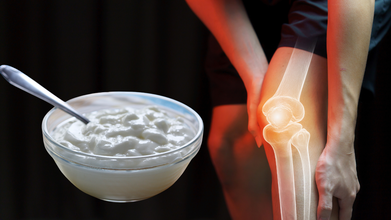- Health Conditions A-Z
- Health & Wellness
- Nutrition
- Fitness
- Health News
- Ayurveda
- Videos
- Medicine A-Z
- Parenting
- Web Stories
Can L-Theanine Really Make You Focus Better? What Science Says About the ‘Calm but Alert’ Effect

Credits: Canva
If you often struggle with stress or restless nights, a warm cup of tea is likely your go-to for calming down. Tea’s comforting reputation isn’t just tradition, studies suggest it can support heart health, aid digestion, and more. One key component behind these benefits is L-theanine, an amino acid found in tea leaves. Available as a supplement, L-theanine is thought to help reduce anxiety, improve sleep, and even enhance focus.
It is gaining popularity as a supplement for enhancing focus and relaxation. But does it live up to the hype? Here's what recent research reveals about its effects on attention, reaction time, and cognitive performance.
What Is L-Theanine?
L-theanine is an amino acid naturally found in tea leaves, especially in green tea and loose-leaf varieties, and is believed to offer several health benefits. But first, it helps to understand what amino acids are and why they matter.
Amino acids are the building blocks of proteins and, ultimately, life itself, as per Healthline. They are molecules used by all living organisms to make proteins. Humans need 20 different amino acids to function properly, 11 of which are essential and must come from food.
Although L-theanine is not essential for survival, research has explored its effects on brain function and cognitive performance.
You can consume L-theanine by drinking teas such as green tea, white tea, or matcha, or by taking it in supplement form, including tablets and capsules.
Can L-Theanine Really Make You Focus Better?
Yes, several studies suggest that L-Theanine can enhance focus and attention. For instance, a 2011 study published in ScienceDirect found that L-Theanine improved attention performance and reaction time in individuals prone to high anxiety.
Additionally, a 2021 study in PubMed Central reported that a single dose of L-Theanine reduced reaction time to attention tasks and increased the number of correct answers in working memory tasks among middle-aged adults.
PMC
L-Theanine appears to have a positive impact on reaction time. A 2025 study published in PubMed found that a 200 mg dose of L-Theanine reduced hit reaction time by 38.65 milliseconds in sleep-deprived individuals during a traffic-related visual recognition task.
PubMed
L-Theanine Effect with Caffeine
When combined with caffeine, L-Theanine may offer enhanced cognitive benefits. A 2010 study in PubMed indicated that the combination of 97 mg of L-Theanine and 40 mg of caffeine improved accuracy during task switching and reduced self-reported tiredness in young adults.
PubMed
L-Theanine: Is It Safe to Use?
L-Theanine is generally considered safe when consumed in moderate amounts, such as those found in tea or supplements. However, as with any supplement, it's advisable to consult with a healthcare provider before starting, especially if you have underlying health conditions or are taking other medications.
L-Theanine shows promise as a natural supplement to enhance focus and reaction time, particularly when combined with caffeine. While more research is needed to fully understand its long-term effects, current studies suggest it can be a useful tool for those seeking improved cognitive performance without the jitteriness associated with other stimulants.
Disclaimer: The information provided is based on current research and should not replace professional medical advice.
Is Bubble Tea Putting Your Health at Risk? Experts Warn About Lead Exposure

Credits: Canva
A trendy drink that’s become a social media favorite may now have fans thinking twice, after questions were raised about one key ingredient.
Bubble tea, also called boba or pearl milk tea, first appeared in Taiwan in the 1980s. It’s usually made with tea, milk or creamer, a sweetener, and, of course, the signature chewy tapioca pearls.
While its colorful, Instagram-worthy appeal has made it popular around the world, recent safety tests from Consumer Reports suggest there could be reason for concern.
Boba Tea Contains Lead?
Bubble tea, the Taiwanese drink made of black tea, milk, sugar, and chewy tapioca pearls, has won fans worldwide since its debut in the 1980s. But recent findings suggest it may deserve a closer look.
A Consumer Reports investigation in the US found high lead levels in some bubble tea products, echoing earlier concerns about cassava-based foods. The tapioca pearls, the drink’s signature “bubbles,” are made from cassava starch, which can absorb lead and other heavy metals from the soil as the plant grows.
Why Are Tapioca Pearls Harmful?
Lead is naturally present in the Earth’s crust, and much of the world’s soil contains significant contamination. Many fruits and vegetables, including cassava, can absorb heavy metals during growth.
Consumer Reports tested tapioca pearls from popular bubble tea chains, Gong Cha and Kung Fu Tea, as well as packaged boba products from Trader Joe’s and WuFuYuan. Every sample contained some lead. Thankfully, none exceeded the levels that Consumer Reports considers concerning, and none had dangerous levels of arsenic, cadmium, or mercury in a single serving.
“These levels weren’t high enough for us to advise people to completely avoid bubble tea,” said James E. Rogers, PhD, director of food safety research and testing at Consumer Reports.
“However, this wasn’t a comprehensive survey of the boba and bubble tea market. The fact that three out of four samples contained more than half of our level of concern for lead in a single serving is a strong reminder that bubble tea should be enjoyed occasionally, rather than as an everyday drink.”
Beyond heavy metals, the starchy composition of tapioca pearls can pose other risks. Eating large amounts may slow stomach emptying, a condition called gastroparesis, or even cause blockages. Symptoms can include nausea, vomiting, and abdominal pain, and people with already slow digestion may be particularly affected.
Bubble Tea and Kidney Health
Bubble tea can also impact kidney health. In 2023, Taiwanese doctors removed more than 300 kidney stones from a 20-year-old woman who reportedly drank bubble tea in place of water. Ingredients such as oxalate and high phosphate levels can contribute to stone formation, though this extreme case likely reflects unusually high consumption.
Jason Tsou, General Manager at WuFuYuan’s parent company, Shanghai ZhouShi Foodstuffs, said the company routinely tests its products for lead through an accredited laboratory. Following these recent findings, they have introduced stricter standards to ensure safety, as per New York Post.
Is Yogurt as Good for Your Bones as It Is for Your Gut?

Credits: Canva
We have been often told that milk, and dairy products are great for our bone health, especially due to its high vitamin D and calcium components. This is also true for yogurt, but is there enough evidence to support this argument? A new study published in the journal Frontiers in Nutrition checks exactly take. It has taken a closer look at the question of eating yogurt to improve bone health. While the findings may show promise, the researchers say that evidence is not strong enough to call yogurt a bone-strengthening food on its own.
Why yogurt Is Believed To Be Bone Healthy?
yogurt is made through fermentation of milk, and it uses two specific bacterial strains, namely: Lactobacillus delbrueckii bulgaricus and Streptococcus thermophilus.
While yogurt and milk share similar nutrient profiles, yogurt offers additional benefits due to the above mentioned bacteria. They also produce vitamins and biologically active compound that could support overall health.
When we age, our bones lose mass and bone formation slows down, while resorption or bone breakdown speeds up. This also increases risk of fragility fractures. This is why nutrients like calcium, vitamin D, phosphorus, and potassium play vital role in maintaining strong bones. yogurt is also rich in protein, calcium, zinc, selenium, and vitamin B and K which is also recommended as bone-friendly food.
Some experts also believe that yogurt offers an edge over milk due to the higher levels of certain vitamins and minerals it provides. Furthermore, they claim that there is a better absorption of nutrients through yogurt. However, despite this theory, the studies have only shown mixed results.
How Was the Study On yogurt's Impact On Bone Health Conducted?
For the latest study, the researcher reviewed the existing evidence on yogurt's impact on bone health. The study analyzed data from scientific databases, including PubMed, Cochrane Library, and Scopus. These were published between 1970 to 2023.
The team had both the groups, namely: healthy adults and individuals with osteoporosis. The study included a comparison of yogurt intake to no yogurt, non-fermented dairy products, or standard osteoporosis treatments. Then, they evaluated observational studies and randomized controlled trials (RCTs), extracting data on participants’ demographics, yogurt dosage, study duration, and results.
In order to ensure accuracy, the study also assessed the quality of evidence using established methods such as the Newcastle-Ottawa scale and the GRADE system. Finally, they conducted meta-analyses to evaluate two major outcomes, hip fracture risk and femoral bone mineral density (BMD).
What Did The Study On Analyzing yogurt's Impact On Bone Health Find?
The study found that of the 1,302 studies reviewed, only 12 met the eligibility criteria that represented 14 observational studies. Most of them were conducted in the US, Europe, and Asia, and focused on postmenopausal women, a group that is particularly vulnerable to bone loss.
There were some studies that found a relation between higher yogurt consumption to better bone mineral density. On fact, one of them even reported that people who consumed yogurt more frequently had a lower risk of radius osteoporosis and higher hip and femoral neck BMD levels.
However, when researchers pooled the data, the overall effect was quite small. The meta-analysis showed that yogurt intake had a statistically positive but clinically negligible impact on bone density (SMD = 0.009) and no clear association with hip fracture risk.
The team also noted several limitations. Most studies didn’t specify the type of yogurt consumed, whether it was full-fat or low-fat, fortified or plain, or contained live bacterial cultures. Since all the data came from observational studies, it was also hard to prove a cause-and-effect link between yogurt and stronger bones.
Can Omega-3 Rich Diet Protect Women From Alzheimer’s? New Study Brings Hope

Credits: Canva
Women should make sure their diets include enough omega fatty acids, researchers say, after finding unusually low levels of these compounds in female Alzheimer’s patients.
This comes from an analysis of blood samples from both Alzheimer’s patients and healthy individuals, which showed that unsaturated fats, including those rich in omega fatty acids, were up to 20% lower in women living with the disease. So, could an omega-rich diet actually help reduce Alzheimer’s risk?
Can Omega-3 Rich Diet Protect Women From Alzheimer’s?
A major study has shown that women with Alzheimer’s have markedly lower levels of unsaturated lipids, including omega fatty acids, in their blood compared to cognitively healthy women. This points to a potential protective role for these fats in maintaining brain health.
Alzheimer’s tends to affect women more, particularly after 80, though the biological reasons are still not fully understood. To explore differences between men and women, researchers analyzed plasma samples from 841 participants in the AddNeuroMed cohort: 306 with Alzheimer’s, 165 with mild cognitive impairment, and 370 cognitively healthy controls. Using lipidomics, they studied 268 individual lipids per participant and examined how lipid composition varied by sex, while also exploring possible causal links through mediation analysis.
The findings revealed clear sex differences. Three lipid groups were linked to Alzheimer’s in women, but only one in men (p<0.05). In women with Alzheimer’s, lipids rich in highly unsaturated fatty acids, including omega fatty acids, were consistently lower, while saturated fats were higher (q<0.05). Importantly, the impact of unsaturated phospholipids on Alzheimer’s risk was independent of cholesterol, LDL, or apolipoprotein B, suggesting a direct biological effect. Men with Alzheimer’s did not show these lipid changes compared to healthy men.
These results highlight that lipid biology in Alzheimer’s is sex-specific, with women showing a clear loss of protective omega-rich fats. While this does not prove a cause-and-effect relationship, it suggests that omega-rich foods like oily fish or supplements could help reduce risk, though clinical trials are needed to confirm this.
How Does Omega Rich Diet Help With Alzheimer's?
A diet high in omega-3 fatty acids may support brain health and lower Alzheimer’s risk through anti-inflammatory, antioxidant, and neuroprotective effects. The most important omega-3s are docosahexaenoic acid (DHA) and eicosapentaenoic acid (EPA), which are essential for proper brain structure and function, according to Healthline.
Women And Alzheimers
About two-thirds of people with Alzheimer’s in the US are women, notes Harvard neuropsychologist Rachel Buckley, PhD. “Women actually tend to live with dementia longer than men.”
Women are more likely to develop Alzheimer’s due to a mix of biological, social, and cultural factors, including longer life expectancy, hormonal changes after menopause, and differences in education and work experience. The disease can also show up differently in women; some studies suggest tau protein spreads faster in their brains, which may delay diagnosis until later stages, according to Harvard Health.
Recent research has highlighted that the reasons for the sex gap in Alzheimer’s are complex, involving both biology and social factors. Potential contributors include women’s exposure to sex hormones, genes on the X chromosome, the presence of risk factors like hearing loss, the APOE4 genetic variant, and lower cognitive reserve related to education levels.
© 2024 Bennett, Coleman & Company Limited

